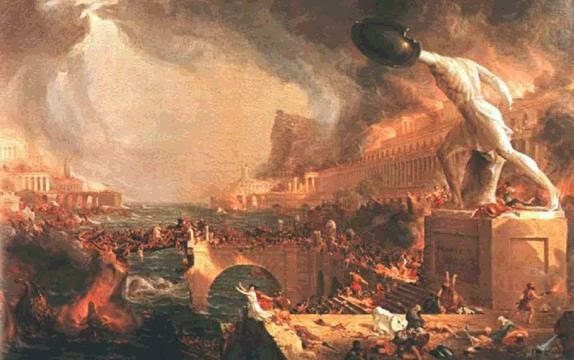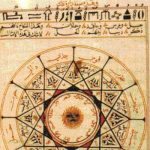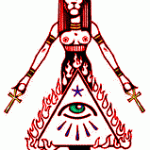By the late fourth and early fifth centuries of our Common Era, the Roman Empire in the west was collapsing under the weight of its own decadence. Every historian has their own opinion about what happened to bring about this “decline and fall” of the great empire, but however it happened, by the turn of the fifth century Rome was no longer the Imperial City. Constantinople reigned as the capital of the eastern portion of the Empire, and most western Emperors preferred Milan or Ravenna to the slums and pestilence of the Eternal City.
To her official poets, Rome remained very much the city “whose beauty no imagination can picture, whose praise no voice can sound, who raises a golden head under the neighboring stars, and with her seven hills imitates the seven regions of heaven; mother of arms and law, who extends her sway over all the earth, and was the earliest cradle of justice: this is the city which, sprung from humble beginnings, has stretched to either pole, from one small place extended its power so as to be coterminous with the light of the sun.”
Claudian, from whose “On the Consulate of Stilicho” these lines are taken, had no idea in 400 A.D. that he was writing Rome’s eulogy. In the same poem, Claudian sounds the major chord of Rome’s greatness: “To her rule of peace we owe it that the world is our home, that we can live where we please, and that to visit Thule and explore its once dreaded wilds is but a sport; thanks to her, all and sundry may drink the waters of the Rhone and quaff Orontes stream. Thanks to her we are all one people.”
An enchanted and grateful Senate erected a statue in Claudian’s honor in the Forum of Trajan, calling him the most glorious of poets. In the aftermath of Stilicho’s assassination in 408, Claudian fell out of favor with the Emperor Honorious, who preferred his poets to rhapsodize over the pleasures of fowl breeding rather than praise troublesome generals, and was either killed or forced to commit suicide. Sic transit gloria. . . Such were the rewards of literary greatness in the early fifth century Roman Empire.
Perhaps it was a blessing that Claudian did not live to see what happened next to his heavenly city.
* * * * *
Fourth century Christians anticipated, as Christ himself had foretold, an apocalyptic Second Coming. After the union of Imperial state and orthodox church, the end of the world came to mean the fall of Rome. “The fall and ruin of the world will soon take place,” predicted Lactantius Firminianous in his Divine Institutions, written early in the fourth century, “but it seems that nothing of the kind is to be feared as long as the city of Rome stands intact.” But as the century wore on, this certainty eroded. Saint Ambrose of Milan, after the Goths had annihilated the imperial army at Adrianople in 378, identified them as Ezekiel’s Gog, and proclaimed “the end of the world is coming upon us.”
Who were these Goths?
Their origin remains obscure, but around the time of Saint John’s Revelation their long march from the far north began. Jordanes, the first Gothic historian, called their homeland Scandza and claimed it was an island whose western shores faced an impassable sea. This could be the Scandinavian peninsula, or possibly the island of Gottland in the Baltic Sea, but at any rate, they landed on the coast of Pomerania, near Danzig, now the Polish city of Gdansk. Trekking southward along the banks of the Vistula, they crossed Poland and the Ukraine and by the third century A. D. had established themselves along the shores of the Black Sea.
The neighboring Roman province of Dacia, now Romania, was both rich and weak, and the Goths turned to foraging off the Empire. The Roman legions and the Gothic hordes met for the first time in 251, deep in the Bulgarian swamps. The Emperor Decius challenged the barbarians and was almost sucessful. The first two lines of the Goths buckled under the Roman assault, but the third held against the tired legionaires. It was the Romans who eventually turned to flee, as the battle swiftly became a massacre. Decius’s body was lost, and his son died as well, killed by an arrow during the retreat. The Goths claimed Dacia, and demanded an annual tribute from Rome to stay north of the Danube.
In the fourth century, many of the Goths were converted by Ulfias, or Little Wolf. The grandson of a couple of Cappadocian Christians captured and enslaved by the Goths, Little Wolf grew up as a Goth but retained his sense of Roman heritage. At age twenty, he was sent, either as a hostage or an envoy, to Constantinople, where he dreamed of returning to the forest and converting his people. Ordained by Eusebius, The Arian Archbishop of Constantinople, Ulfias translated the Bible into Gothic — leaving out the Book of Kings because he felt the Goths were bellicose enough without scriptural authority. Returning to Dacia, he was at first repulsed, but around 350, returned with a large group of Gothic converts. But even as he made headway with the pagan Goths, Ulfias’ Arian views were on their way to becoming branded as heresy. In 380, three years before Ulfias’s death, the Emperor Theodosius officially pronounced anathema on the type of Christianity to which Ulfias had converted the Goths.
As if heresy were not enough, just as the Goths were on their way to becoming a buffer state on the borders of the great Roman Empire, the Huns appeared from the east. Originally named the Hiung-nu, or slaves, by the Chinese, who drove them westward across the steppes ahead of their invading armies, the Huns were a sort of scourge which historians such as Jordanes had trouble believing were human. He relates that they were the children of witches and unclean spirits, “. . .scarcely human. . .fiercer than ferocity itself.”
Claudian, in his usual elegant style, has left us a portrait of the Huns: “The Northern Bear looked down on no uglier crew/ Base is their garb, their bodies foul to view;/Their souls are ne’er subdued to sturdy toil/ Or Cere’s art, their subsistance is spoil.”
The Huns fell first on the Gothic tribes to the northwest of the Black Sea. Three great barbarian battles, struggles of entire peoples, (great masses of warriors, their wives and children engaged in deadly combat against the savage horsemen) were fought until, on the banks of the Dniester River, the Goths were utterly routed. The remnants of the whole Gothic nation fled for the protection of the Roman Empire.
The Emperor Valens granted asylum in 376, and settled them in the same Bulgarian swamp where the Goths had defeated the Emperor Decius. The Goths became colonists of the Empire, sworn to defend its borders. This swarm of refugees was hardly the conquering barbarian horde of Imperial legend, or so the greedy Roman adminstrators thought. They imposed heavy taxes and tried to assassinate the Gothic leader, Fritigern. In 378, the Goths rose in revolt and marched to attack Adrianople, 150 miles from Constantinople. The Emperor Valens, without waiting for reinforcements, rode out to subdue them.
At first, the discipline of the legions gave Rome the advantage in close combat. But at an unexpected moment, the Gothic heavy cavalry charged the Roman flank and swept them away. Ammianus Marcellinus, a contemporary chronicler, called it the worst disaster since Cannae, the crushing Roman defeat by Hannibal in 216 B.C. The battle of Adrianople was indeed a turning point, the “coming of the end of the world” as Saint Ambrose had predicted. It marked the beginning of a barbarian invasion that would, within thirty years, throw the western Empire into chaos, and eventually, oblivion. Adrianople also proved the value of heavy armored horsemen, and so began the rise of the mounted warrior class which would in time become the “Flower of Knighthood.”
* * * * *
Despite the disasters, Rome still stood. Theodosius the Great re-unified the eastern and western halves of the Empire, briefly, and order was restored to the Balkans. When Theodosius died, the stage was set for the surreal parody of a Greek tragedy known as the “Sack of Rome. ” It would take the talents of a Fellini, a Shakespeare and a Barnum to do justice to this absurd and tangled drama, but for our purposes, only the high, and the low, spots are necessary.
The Goths settled in Bulgaria, keeping their ethnic culture intact. But they were ready to fight for the empire. In 392, the Roman general Arbogastes, a Frank, strangled to death the western Emperor Valentinian and replaced him with Eugenius. The Goths rallied to Theodosius, and among them was a young noble of the Balthi clan named Alaric. With the Goths on his side, Theodosius was invincible. Eugenius was killed as he lay begging for mercy; Arbogastes fell on his own sword. The Goths saved the empire, but four months later Theodosius was dead.
Theodosius left the eastern portion of his empire to his son Arcadius, the western to Honorius. An effete weakling, with no interests other than his pet birds, Honorius at least meant well and had good morals, for an Emperor. Arcadius, however, was a true chip off the old Imperial block, a throw-back to the age of Nero and Claudius. Administration of the empire, both halves, were left to sycophants and opportunists, with the usual predictable results.
In the western empire, Imperial Chancellor Olympius epitomizes the type, as does Rufinius in the east. For what they believed to be the best of reasons, these patrician Romans, though they were Greek and Armenian, would conspire to kill the Empire itself. Contrasted to this is the Vandal, General Stilicho, who saved the Empire on at least three major occasions, and would go to his death a martyr to Roman justice. And of course, none of this would have been quite so lethal without the Imperial ambitions of Alaric the Goth, a Christian of the Arian persuation who had learned the arts of war as a follower of the great Theodosius. Motivated mainly by a desire to become the commander in chief of the Imperial forces, Alaric would stumble his way through rivers of blood until he, almost unwillingly, plundered the Eternal City.
After Theodosius’s death, Alaric rose to the kingship of the Visigoths, or western Goths and began to threaten the eastern approachs to the Imperial capitial, Constantinople. Here the Emperor Arcadius and the sycophant Rufinius entered the scene, scheming all the while. Instead of ravaging the eastern empire, Arcadius’ realm, it was subtly suggested that Italy and its rich provinces made for better and easier pickings. Arcadius hoped that the Visigoths would keep Stilicho and his ambitions busy, and whatever happened, Arcadius could then step in and pick up the pieces.
Twice, Alaric invaded Italy and was beaten back by the military prowess of General Stilicho. The good General, Defender of Rome, was a Spaniard who had also trained with Theodosius and was by far and away the greatest military leader of the age. Stilicho understood the situation in the empire and realized that it was much better to make allies of the Visigoths than to try to annihilate them. It was this willingness to negotiate with Alaric that led to the General’s downfall.
To Olympius and the Roman Senate, it was inconceivable that a Roman general preferred to negotiate. They were surfeited with tales of Roman greatness and could only see treachery in Stlicho’s realism. Olympius convinced Honorius — which wasn’t hard: Honorius usually believed the last person with which he spoke — that Stilicho was actively plotting with Alaric to overthrow the Emperor. Only a threat to his person, or his beloved fowls, could rouse the diffident Emperor. Thoroughly frightened, Honorius ordered an Imperial hit squad to kill Stilicho.
The General’s friends were ready to resist, but Stilicho refused, unwilling to dishonor what he had fought so hard to preserve. He offered his neck to the sword and died a martyr to Romanitas. Claudian called him the last of the Romans and followed him into oblivion. A few months later, Alaric re-entered Italy at the head of the Visigothic hordes.
The legions were demoralized by Stilicho’s death and disorganized by the persecutions of his friends and supporters. After extensive pillaging in northern Italy, while Honorius cowered behind the swamps of Ravenna, the Goths swept down on Rome. On August 24, 410 A.D., Alaric’s forces entered the city to spend a hectic three days looting the corpse of Imperial Rome.
The image lingers, even in our post-modern unconscious. The blazing city, its gates shattered, its citizens raped and slaughtered by savage barbarians, its treasure plundered, has become a symbol of the triumph of chaos over the forces of order. “Quid salvum est si Roma perit?” Saint Jerome wrote soon after the fall of Rome. What is safe if Rome perishes?
* * * * *
In the fantasy world of Ravenna, according to Procopius, the Imperial chamberlain came rushing to tell Honorius that Rome had perished.
“Rome perished!” Honorius shrieked. “Tis not an hour she was feeding from my hand.”
Whereupon the chamberlain was forced to explain that he meant the city of Rome, not the chicken Honorius had named after his capital. The Emperor was relieved, “I thought, my friend, that you meant that I had lost my bird, Rome.”
* * * * *
Rome survived to be plundered again and again. (Some of the worst destruction was caused by the Holy Roman Emperor Charles V more than a thousand years later.) But, to the religious minded Romans, both Christian and pagan, the sacking of the great city was an event of supernatural significance. Pagans thought it fitting punishment for the lack of faith in the old gods. Christians struggled with this in any way they could. From this need to justify catastrophe would come Saint Augustine’s masterpiece, The City of God.
By the traditional date for the “Fall” of Rome, 476 A. D., which merely marked the moment the usurpers of Roman power no longer felt it necessary to assume the title of Emperor, Europe was deep into the Dark Ages. What made these coming centuries so “dark?”
First and perhaps foremost, the descent of the political darkness completed the Christianization of the Empire. Alaric, as a Christian, had respected church property, and therefore the destruction in Rome had fallen most directly on the remaining pagan colleges and temples. Powerful pagans remained in the Empire. As late as the Eugenius/Arbogastes revolt of 392, paganism was a political issue. But after 410, their academies and colleges shattered, their priesthood obliterated, the influence of classical paganism dwindled rapidly. In Europe, Christianity would have no organized rivals but those from inside the Church.
The Empire did not become completely Christian in the west, however, until the political structure of Rome itself had collapsed. In this vacuum of political and cultural leadership, the Church became the sole custodian and arbitrator of civilization, with devastating results. Rome, for all its faults, supplied what Claudian had called the sense that “we are all one people.” (This unity and universal focus created a world view which we retain to this day. That the Imperial Christianity of the next thousand years failed utterly to restore the Peace of Rome has, however, been lost on every power hungry national leader from Theodoric to George Bush. Hic Eternae Roma. . .) This sense of citizenship was eroded as the central authority disintegrated. The very shape of future national identities arose from the fragments of the Empire, much as our modern European languages emerged from the influence of Latin.
As the Empire grew weaker, the local darkness thickened. Where once information, trade and military might had flowed through the arteries of the Empire, now each province had to shift for itself, grow its own food, fight its own battles. Nowhere do we see more clearly than in Britain.
Play the ancient Rome inspired game Caesars Empire Slot for free at http://demofreeslots.com/game/caesars-empire-slot/. Try out more free slots at DemoFreeSlots.com.
More Articles from Sangraal.com:
Submit your review | |








